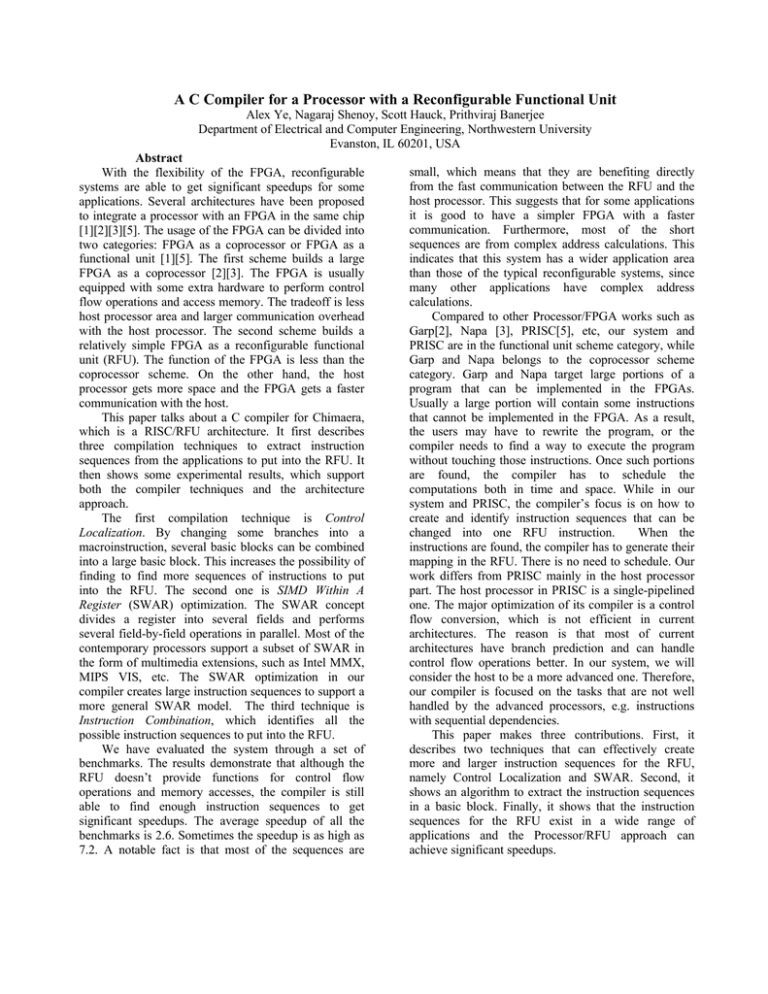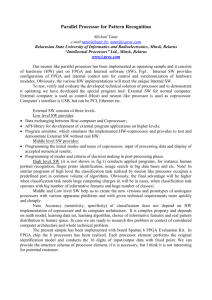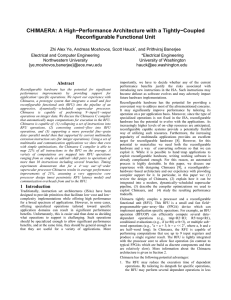A C Compiler for a Processor with a Reconfigurable Functional...
advertisement

A C Compiler for a Processor with a Reconfigurable Functional Unit
Alex Ye, Nagaraj Shenoy, Scott Hauck, Prithviraj Banerjee
Department of Electrical and Computer Engineering, Northwestern University
Evanston, IL 60201, USA
Abstract
With the flexibility of the FPGA, reconfigurable
systems are able to get significant speedups for some
applications. Several architectures have been proposed
to integrate a processor with an FPGA in the same chip
[1][2][3][5]. The usage of the FPGA can be divided into
two categories: FPGA as a coprocessor or FPGA as a
functional unit [1][5]. The first scheme builds a large
FPGA as a coprocessor [2][3]. The FPGA is usually
equipped with some extra hardware to perform control
flow operations and access memory. The tradeoff is less
host processor area and larger communication overhead
with the host processor. The second scheme builds a
relatively simple FPGA as a reconfigurable functional
unit (RFU). The function of the FPGA is less than the
coprocessor scheme. On the other hand, the host
processor gets more space and the FPGA gets a faster
communication with the host.
This paper talks about a C compiler for Chimaera,
which is a RISC/RFU architecture. It first describes
three compilation techniques to extract instruction
sequences from the applications to put into the RFU. It
then shows some experimental results, which support
both the compiler techniques and the architecture
approach.
The first compilation technique is Control
Localization. By changing some branches into a
macroinstruction, several basic blocks can be combined
into a large basic block. This increases the possibility of
finding to find more sequences of instructions to put
into the RFU. The second one is SIMD Within A
Register (SWAR) optimization. The SWAR concept
divides a register into several fields and performs
several field-by-field operations in parallel. Most of the
contemporary processors support a subset of SWAR in
the form of multimedia extensions, such as Intel MMX,
MIPS VIS, etc. The SWAR optimization in our
compiler creates large instruction sequences to support a
more general SWAR model. The third technique is
Instruction Combination, which identifies all the
possible instruction sequences to put into the RFU.
We have evaluated the system through a set of
benchmarks. The results demonstrate that although the
RFU doesn’t provide functions for control flow
operations and memory accesses, the compiler is still
able to find enough instruction sequences to get
significant speedups. The average speedup of all the
benchmarks is 2.6. Sometimes the speedup is as high as
7.2. A notable fact is that most of the sequences are
small, which means that they are benefiting directly
from the fast communication between the RFU and the
host processor. This suggests that for some applications
it is good to have a simpler FPGA with a faster
communication. Furthermore, most of the short
sequences are from complex address calculations. This
indicates that this system has a wider application area
than those of the typical reconfigurable systems, since
many other applications have complex address
calculations.
Compared to other Processor/FPGA works such as
Garp[2], Napa [3], PRISC[5], etc, our system and
PRISC are in the functional unit scheme category, while
Garp and Napa belongs to the coprocessor scheme
category. Garp and Napa target large portions of a
program that can be implemented in the FPGAs.
Usually a large portion will contain some instructions
that cannot be implemented in the FPGA. As a result,
the users may have to rewrite the program, or the
compiler needs to find a way to execute the program
without touching those instructions. Once such portions
are found, the compiler has to schedule the
computations both in time and space. While in our
system and PRISC, the compiler’s focus is on how to
create and identify instruction sequences that can be
changed into one RFU instruction.
When the
instructions are found, the compiler has to generate their
mapping in the RFU. There is no need to schedule. Our
work differs from PRISC mainly in the host processor
part. The host processor in PRISC is a single-pipelined
one. The major optimization of its compiler is a control
flow conversion, which is not efficient in current
architectures. The reason is that most of current
architectures have branch prediction and can handle
control flow operations better. In our system, we will
consider the host to be a more advanced one. Therefore,
our compiler is focused on the tasks that are not well
handled by the advanced processors, e.g. instructions
with sequential dependencies.
This paper makes three contributions. First, it
describes two techniques that can effectively create
more and larger instruction sequences for the RFU,
namely Control Localization and SWAR. Second, it
shows an algorithm to extract the instruction sequences
in a basic block. Finally, it shows that the instruction
sequences for the RFU exist in a wide range of
applications and the Processor/RFU approach can
achieve significant speedups.
RFUOP can read from all the registers connected to the RFU
and then put the result on the result bus. The maximum number
of input registers is 9 in Chimaera. Each RFUOP instruction is
Host
Processor
1 Introduction
With the flexibility of the FPGA, reconfigurable systems
are able to get significant speedups for some applications. As
the general purpose processor and the FPGA each has its own
suitable area of applications, several architectures are proposed
to integrate a processor with an FPGA in the same chip. The
usage of the FPGA in them can be divided into two categories:
FPGA as a coprocessor or FPGA as a functional unit.
In the coprocessor schemes such as Garp[2] and Napa[3],
the host processor is coupled with an FPGA based
reconfigurable coprocessor. The coprocessor usually has the
ability of accessing memory and performing control flow
operations. There is a communication cost between the
coprocessor and the host processor, which is several cycles or
more. Therefore, these architectures tend to map a large portion
of the application, e.g. a loop, into the FPGA. One calculation
in the FPGA usually corresponds to a task that takes several
hundred cycles or more.
In the functional unit schemes such as Chimaera[1] and
PRISC[5], the host processor is integrated with an FPGA based
Reconfigurable Functional Unit (RFU). One RFU Operation
(RFUOP) can take on a task which usually requires several
instructions on the host processor. As the functional unit is
interfaced only with the register file, it cannot perform memory
operations or control flow operations. The communication is
faster than the coprocessor scheme. For example, in the
Chimaera architecture, after an RFUOP’s configuration is
loaded, an invocation of it has no overhead in communication.
This gives such architecture a larger range of application. Even
in cases where only a few instructions can be combined into
one RFUOP, we could still apply the optimization if the
execution frequency is high enough.
In this paper, we talk about a C compiler for a RISC
processor with an RFU. The target architecture is Chimaera.
We describe how the compiler identifies sequences of
statements in a C program and changes them into RFUOPs. We
show the performance benefits that can be achieved by such
optimizations over a set of benchmarks.
The paper is organized into five sections. In Section 2, we
give an overview of the Chimaera architecture. Section 3
discusses the compiler organization and implementation in
detail. In this section, we first discuss a technique to enhance
the size of the instruction sequence: control localization. Next,
we describe the application of the RFU to SIMD Within A
Register (SWAR) operations. Lastly, we introduce an
algorithm to identify RFUOPs in a basic block. Section 4
demonstrates some experimental results. We summarize this
paper in Section 5.
(Shadow) Register File
result bus
RFU
Figure 1. The overall Chimaera architecture
associated with a configuration and an ID. For example, an
execution sequence “r2=r3<<2; r4=r2+r5; r6=lw 0(r4)” can be
optimized to “r4=RFUOP #1; r6=lw 0(r4)”. Here #1 is the ID of
this RFUOP and “r5+r3<<2” is the operation of the
corresponding configuration. After an RFUOP instruction is
fetched and decoded, the Chimaera processor checks the RFU
for the configuration corresponding to the instruction ID. If the
configuration is currently loaded in the RFU, the corresponding
output is written to the destination register during the instruction
writeback cycle. Otherwise, the processor stalls when the RFU
loads the configuration.
3 Compiler Implementation
We have generated a C compiler for Chimaera which
automatically maps some operations into RFUOPs. The
C code
GCC Parser
RTL
GCC Early
Optimizations
Control
Localization
SWAR
optimization
Chimaera
Optimization
Instruction
Combination
RTL optimized for Chimaera
GCC Later
Optimizations
2 Chimaera Architecture Overview
The overall Chimaera architecture is shown in Figure 1.
The main component of the system is the Reconfigurable
Functional Unit, which consists of FPGA-like logic designed to
support high-performance computations. It gets inputs from the
host processor’s register file, or a shadow register file which
duplicates a subset of the values in the host’s register file.
The RFU contains several configurations at the same time.
An RFUOP instruction will activate the corresponding
configuration in the RFU. An RFU configuration itself
determines from which registers it reads its operands. A single
assembly code with RFUOP
RFUOP configuration information
Figure 2: Phase ordering of the C compiler for Chimaera
generated code is run on a Chimaera simulator.
The compiler is built using the widely available GCC
framework[6]. Figure 2 depicts the phase ordering of the
implementation. The C code is parsed into the intermediate
language of GCC: Register Transfer Language (RTL), which is
then enhanced by several early optimizations such as common
2
expression elimination, flow analysis, etc. The partially
optimized RTL is passed through the Chimaera optimization
phase, as will be explained below. The Chimaera optimized
RTL is then processed by later optimization phases such as
instruction scheduling, registers allocation, etc. Finally, the
code for the target architecture is generated along with RFUOP
configuration information.
From the compiler’s perspective, we can consider an
RFUOP as an operation with multiple register inputs and a
single register output. The goal of the compiler is to identify
the suitable multiple-input-single-output sequences in the
programs and change them into RFUOPs.
Chimaera Optimization consists of three steps: Control
Localization,
SWAR
optimization
and
Instruction
Combination. Due to the configuration loading time, these
optimizations can be applied only in the kernels of the
programs. Currently, we only optimize the innermost loop in
the programs.
The first step of Chimaera optimization is control
localization. It will transform some branches into one
macroinstruction to form a larger basic block. The second step
is the SIMD Within A Register (SWAR) Optimization. This
step searches the loop body for subword operations and unrolls
the loop when appropriate. The third step is instruction
combination. It takes a basic block as input and extracts the
multiple-input-single-output patterns from the data flow graph.
These patterns are changed into RFUOPs if they can be
implemented in RFU. The following subsections discuss the
three steps in detail.
macroin
(a)
(b)
Figure 3:
(a)
(b)
control flow graph before control localization. Each oval is
an instruction, and the dashed box marks the code sequence
to be control localized.
control flow graph after control localization
MMX, HP MAX, SUN SPARC VIS, etc. For example,
“PADDB A, B” is an instruction from Intel MMX. Both
operands A and B are 64-bit and are divided into eight 8-bit
fields. The instruction performs eight additions in parallel and
stores the eight results to A.
However, current implementations of SWAR do not support
a general SWAR model. Some of their limitations are:
•
The input data must be packed and aligned correctly,
causing packing and unpacking penalties sometimes.
•
Most of current hardware implementations support 8, 16
and 32-bit field size only. Other important sizes such as 2bit and 10-bit are not supported.
•
Only a few operations are supported. When the operation
for one item becomes complex, SIMD is impossible. For
example, the following code does not map well to a simple
sequence of SIMD operations:
char out[100],in1[100],in2[100];
for(i=0;i<100;i++) {
if ((in1[i]-in2[i])>10)
out[i]=in1[i]-in2[i];
else
out[i]=10;}
With the flexibility of the FPGA, the RFU can support a
more general SWAR model without the above disadvantages.
The only requirement is that the output fields should fit within a
single register. The inputs don’t need to be stored in packed
format, nor is there limitation on the alignment. In addition,
complex operations can be performed. For example, the former
example can be implemented in one RFUOP.
Our compiler currently supports 8-bit field size, which is the
size of “char” in C. In current implementation, the compiler
looks for the opportunity to pack several 8-bit outputs into a
word. In most cases, this kind of pattern exists in the loop with
stride one. Therefore, the compiler searches for the pattern such
that the memory store size is a byte and the address changes by
one for each loop iteration. When such patterns are found, the
loop is unrolled four times. In the loop unrolling, conventional
optimizations such as local register renaming and strength
reduction are performed. In addition, the four memory stores are
changed to four sub-register movements. For example,
“ store_byte r1,address;
store_byte r2,address+1;
store_byte r3,address+2;
store_byte r4,address+3;”
are changed into
“(r5,0)=r1; (r5,1)=r2;
(r5,2)=r3;(r5,3)=r4;”.
3.1 Control Localization
In order to get more speedup, we want to find larger and
more RFUOPs. Intuitively, a larger basic block contains more
instructions, thus has more chances of finding larger and more
RFUOPs. We find that control localization technique [4][5] is
useful in increasing the size of basic blocks. Figure 3 shows an
example of it. After control localization, several branches are
combined into one macroinstruction, with multiple output and
multiple input. In addition to enlarging the basic block, the
control localization sometimes finds RFUOPs directly. When a
macroinstruction has only one output, and all the operations in
it can be implemented in the RFU, this macroinstruction can be
mapped into an RFUOP. This RFUOP can speculatively
compute all operations on different branch paths. The result on
the correct path where the condition evaluates to true is
selected to put into the result bus. This macro instruction is
called as “CI macroin” and can be optimized by Instruction
Combinaton.
3.2 SWAR Optimization
As a method to exploit medium-grain data parallelism,
SIMD (single instruction, multiple data) has been used in
parallel computers for many years. Extending this idea to
general purpose processors has led to a new version of SIMD,
namely SIMD Within A Register (SWAR)[7]. The SWAR
model partitions each register into fields that can be operated
on in parallel. The ALUs are set up to perform multiple fieldby-field operations. SWAR has been successful in improving
the multimedia performance. Most of the implementations of
this concept are called multimedia extensions, such as Intel
3
The notation (r, n) refers to the nth byte of register r. We
generate a pseudo instruction "collective-move" that moves the
four sub-registers into a word register, e.g. “r5=(r5,0)
(r5,1) (r5,2) (r5,3)”. In the data flow graph, the four
outputs merge through this “collective-move” into one. Thus a
multiple-input-single-output subgraph is formed. The next step,
Instruction Combination, can recognize this subgraph and
change it to an RFUOP when appropriate. Finally, a memory
store instruction is generated to store the word register. The
compiler then passes the unrolled copy to the instruction
combination step.
We categorize instructions into Chimaera Instruction (CI)
and Non-Chimaera Instruction (NCI). Currently CI includes
logic operation, constant shift and integer add/subtract. The
“collective_move”, “subregister movement” and “CI macroin”
are also considered as CI. NCI includes other instructions such
as multiplication/division, memory load/store, floating-point
operation, etc.
The algorithm FindSequences in Figure 3 finds all the
maximum instruction sequences for the RFU. It colors each
node in the data flow graph(DFG). The NCI instructions are
marked as BLACK. A CI instruction is marked as BROWN
when its output must be put into a register, that is, the output is
live-on-exit or is the input of some NCI instructions. Other CI
instructions are marked as WHITE. The RFU sequences are the
subgraphs in the DFG that consists of BROWN nodes and
WHITE nodes.
The compiler currently changes all the identified sequences
into RFUOPs. Under the assumption that every RFUOP takes
one cycle and the configuration loading time can be amortized
over several executions, this gives an upper bound of the
speedup we could expect from Chimaera. In the future, we will
take into account other factors such as the FPGA size,
configuration loading time, actual RFUOP execution time, etc.
ALGORITHM: FindSequences
INPUT:DFG G, NCI, CI, Live-on-exit registers R
OUTPUT: A set of RFU sequences S
begin
S=∅
for each node n∈G
Color(n) ←WHITE
end
for each node n∈NCI
Color(n) ←BLACK
for each node p∈Pred(n)
if p∈CI then
Color(p) ←BROWN
endif
end
end
for each register r∈R
n← the last node that updates r in G
if n∈CI then
Color(n) ←BROWN
endif
end
for each node n∈G
if Color(n)=BROWN then
sequence=∅
AddSequence(n, sequence)
if sizeof(sequence)>1 then
S=S∪{sequence}
endif
endif
end
end
4 Experimental Results
We have tested the compiler’s output through a set of
benchmarks on the Chimaera simulator. The simulator is a
modification of SimpleScalar Simulator[6]. The simulated
architecture has 32 general purpose 32-bit registers and 32
floating point registers. The instruction set is a superset of
MIPS-IV ISA. Presently, the simulator executes the programs
sequentially and gathers the instruction count. Our future goal is
to obtain more realistic results, considering multiple pipelines,
configuration loading time and out-of-order execution.
Early results on some benchmarks are presented in this
section. Each benchmark is compiled in two ways: one is using
“gcc -O2”, the other is using our Chimaera compiler. We studied
the differences between the two versions of assembly codes as
well as the simulation results. In the benchmarks, decompress.c
and compress.c are from Honeywell benchmark[10], jacobi and
life are from Raw benchmark[9], image reconstruction[8] and
dct[11] are implementations of two program kernels of MPEG,
image restoration is an image processing program. They are
noted as dcmp, cmp, life, jcbi, dct, rcn and rst in the following
figure.
AddSequence( n, sequence)
begin
if Color(n)=(BROWN or WHITE) then
sequence←sequence∪{n}
dcmp
cmp
jcbi
life
dct
rcn
rst
avg
for each p∈Pred(n)
AddSequence(p, sequence)
end
endif
end
Figure 3: Algorithm to find RFU sequences
3.3 Instruction Combination
The instruction combination step analyzes a basic block
and changes the RFU sequences into RFUOPs. It first finds out
what instructions can be implemented in the RFU. It then
identifies the RFU sequences. At last, it selects the appropriate
RFU sequences and changes them into RFUOPs.
insn1
37.4M
34.2M
2.1M
6.7M
78.4M
11M
22.3M
-
insn2
32.7M
28.6M
1.3M
5.0M
52.6M
2.6M
3.1M
-
Speedup
1.14
1.20
1.63
1.34
1.49
4.23
7.19
2.60
IC
100%
80%
94%
100%
10%
6%
16%
22%
CL
0
20%
6%
0
82%
10%
0
7%
SWAR
0
0
0
0
8%
84%
84%
61%
Figure 4: Performance results over some benchmarks. The "avg"
row is the average of all benchmarks.
Figure 4 shows the simulation results of the RFU
optimizations. Insn1 and insn2 are the instruction counts without
and with RFU optimization. The speedup is calculated as
4
insn1/insn2. The following three columns IC, CL and SWAR
stand for the portion of performance gain from Instruction
Combination, Control Localization and SWAR respectively.
The three optimizations give an average speedup of 2.60. The
best speedup is up to 7.19.
most of the sizes are from 2 to 6. These small sizes indicate that
these techniques are benefiting from the fast communication of
the functional unit scheme. In the coprocessor scheme, the
communication overhead would make them prohibitive to apply.
In summary, the results show that the compilation
techniques are able to create and find many instruction
sequences for the RFU. Most of their sizes are several
instructions, which demonstrate that the fast communication is
necessary. The system gives an average speedup of 2.6.
22.30%
9.80%
NC
5.40%
IC
.5 Conclusion
This paper describes a C compiler for the Processor/FPGA
architecture when the FPGA is served as a Reconfigurable
Functional Unit (RFU).
We have introduced an instruction combination algorithm to
identify RFU sequences of instructions in a basic block. We
have also shown that the control localization technique can
effectively enlarge the size of the basic blocks and find some
more sequences. In addition, we have illustrated the RFU
support for SWAR. By introducing “sub-register movement”
and “collective-move”, the instruction combination algorithm is
able to identify complex SIMD instructions for the RFU.
Finally, we have presented the experimental results which
demonstrate that these techniques can effectively create and
identify larger and more RFU sequences. With the fast
communication between RFU and the processor, the system can
achieve considerable speedups.
CL
SWAR
62.50%
Figure 5: Distribution of the kernel instructions
To illustrate the impact of each optimization on the kernel
sizes, we categorize instructions into four types: NC, IC, CL
and SWAR. NC is the part of instructions that cannot be
optimized for Chimaera. NCI instructions and some noncombinable integer operations fall in this category. IC, CL and
SWAR stand for the instructions that can be optimized by
Instruction Combination, Control Localization and SWAR
optimization respectively. Figure 5 shows the distribution of
these four types of instructions in the program kernels. After
the three optimizations, the kernel size can be reduced by an
average of 37.5%. Of this amount, 22.3% is from Instruction
Combination, 9.8% from Control Localization and 5.4% from
SWAR.
Further analysis shows that 58.4% of the IC portion comes
from address calculation. For example, the following C code
“int a[10], ...=a[i]” is translated to "r3=r2<<2,
r4=r3+r1, r5=lw 0(r3)" in assembly. The first two
instructions can be combined in Chimaera. The large portion of
address calculation indicates that our optimizations can be
applied to a wide range of applications, as long as they have
complex address calculations in the kernel. Furthermore, as the
address calculation is basically sequential, existing ILP
architectures like superscalar and VLIW cannot take advantage
of it. This suggests that we may expect speedup if we integrate
a RFU into an advanced ILP architecture.
IC
CL
SWAR
6
7 ... 16 ... 32 ... 36 ... 52
References
[1] Omitted for anonymous reviewing
[2] John R. Hauser and John Wawrzynek. GARP: A MIPS
processor with a reconfigurable coprocessor. Proceedings
of IEEE Workshop on FPGAs for Custom Computing
Machines (FCCM), Napa, CA, April 1997.
[3] M.B. Gokhale, et al. Napa C: Compiling for a Hybrid
RISC/FPGA Architecture, FCCM 98, CA, USA
[4] Walter Lee, Rajeev Barua and et al. Space-Time
Scheduling of Instruction-Level Parallelism on a Raw
Machine, MIT. ASPLOS VIII 10/98, CA, USA
[5] R. Razdan, PRISC: Programmable Reduced Instruction Set
Computers, Ph.D. Thesis, Harvard University, Division of
Applied Sciences,1994
[6] http://www.cs.wisc.edu/~mscalar/simplescalar.html
[7] Paolo Faraboschi, et al. The Latest Word in Digital and
Media Processing, IEEE signal processing magazine, Mar
1998.
[8] Selliah Rathnam, et al. Processing the New World of
Interactive Media, IEEE signal processing magazine March
1998
[9] J.Babb, M.Frank, et al. The RAW benchmark Suite:
Computation Structures for General Purpose Computing.
FCCM, Napa Vally, CA, Apr.1997
[10] Honeywell Inc,
http://www.htc.honeywell.com/projects/acsbench/
[11] Koichi Atsuta, ET5Lab Compression Group,
http://marine.et.u-tokai.ac.jp/database/koichi.html.
[12] Compiling For SIMD Within A Register, Randall J. Fisher
and Henry G. Dietz, 1998 Workshop on Languages and
Compilers for Parallel Computing, North Carolina, Aug
1998
Frequency
35%
30%
25%
20%
15%
10%
5%
0%
2
3
4
5
RFUOP size
Figure 6: The frequency of RFUOP sizes. IC, CL and SWAR
are the RFUOPs generate by Instruction Combination, Control
Localization and SWAR respectively.
Figure 6 illustrates the frequencies of different RFUOP
sizes. For Instruction Combination and Control Localization,
5





